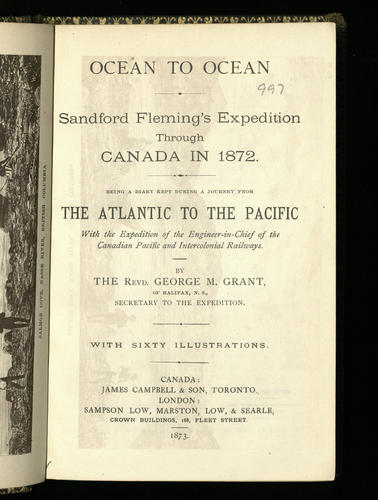Ocean to Ocean 1873
RCIN 1024352
-
In July 1871, British Columbia joined Canada as its sixth province. However, this new province on the Pacific Ocean was isolated from the rest of the country by the Rocky Mountains and the sparsely populated prairies. As a condition to its entry to the nation, the Canadian government promised to construct a transcontinental railway to connect the province to the rest of the country.
Although the United States had connected its eastern states to California and the Pacific coast by rail in the 1860s, no such effort had previously been made in Canada. The endeavour was to be the largest engineering project to date, aiming to connect the wealthy cities in Quebec and Ontario with new markets in Western Canada. It was also a major ambition in the attempts to unite such a sparsely populated country which had only achieved self-government four years previously.
On the day of British Columbia's accession as a province, surveyors for the two major Canadian railway companies set off from Ottawa and Victoria and began to survey the proposed route which was intended to travel from Montreal to the west, and published their reports the following spring. It was recommended by the Canadian government that the new railway ought to travel only through Canadian land, traversing the rocky terrain of the Canadian Shield, rather than passing through easier terrain in the American states of Wisconsin and Minnesota.
Following the publication of these reports, the Engineer-in-Chief of the Canadian Pacific Railway, Sir Sandford Fleming, proposed that it would be best if he followed the proposed route in person. He outfitted an expedition which would set off from Toronto in July 1872 and would aim to reach Victoria in the autumn. Fleming gathered a team of engineers from the company and asked his friend George Monro Grant, an influential figure in Nova Scotia's acceptance of confederation in 1867 and keen supporter of the idea of a Canadian nation, to accompany the group as Fleming's Secretary.
This book is a copy of Grant's account of the expedition, published to be "of interest to the general public, and of value to intending immigrants". It provides a detailed travelogue of the journey, complete with illustrations taken from photographs, which describes with vigour the beauty of the country and the difficulties faced in crossing such a vast expanse of terrain.
The Canadian Pacific Railway eventually began construction in 1881, after being postponed by a political scandal in the mid-1870s as well as an international recession, and was completed in 1885. It was the longest railway constructed at the time and was instrumental in attracting new immigrants to settle in British Columbia and the Prairie Provinces. Although air travel has taken many passengers away, the railway is still an important artery for freight transport, moving coal and grain as well as other goods across vast distances.
-
Creator(s)
(publisher) -
Category
-
Alternative title(s)
Ocean to ocean : Sandford Fleming's expedition through Canada in 1872 : being a diary kept... / by the Revd. George M. Grant.










